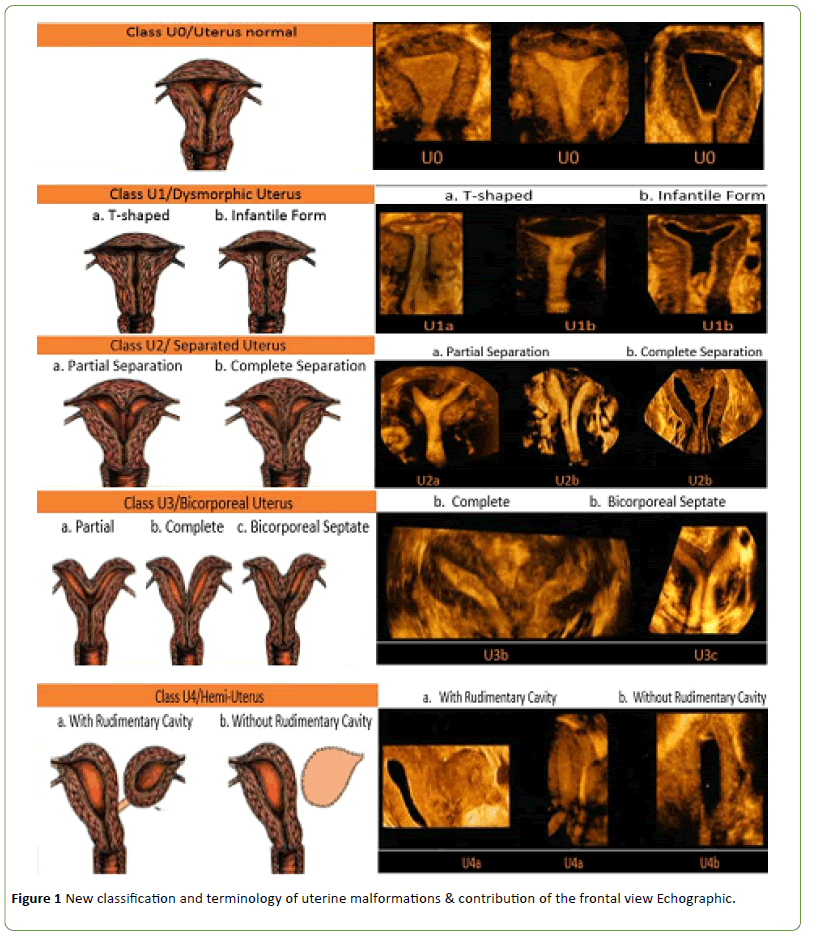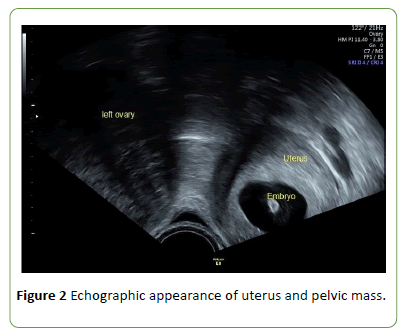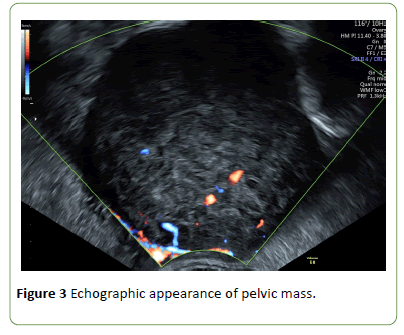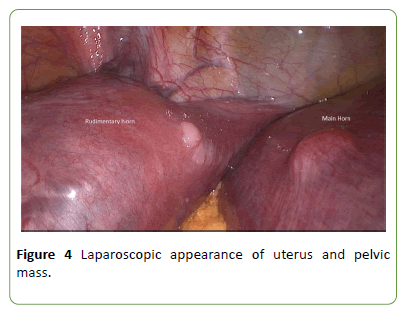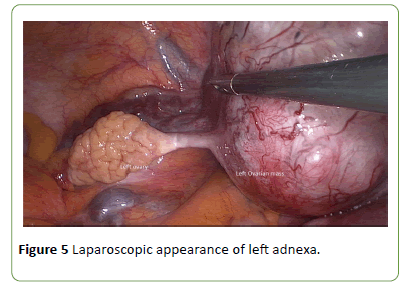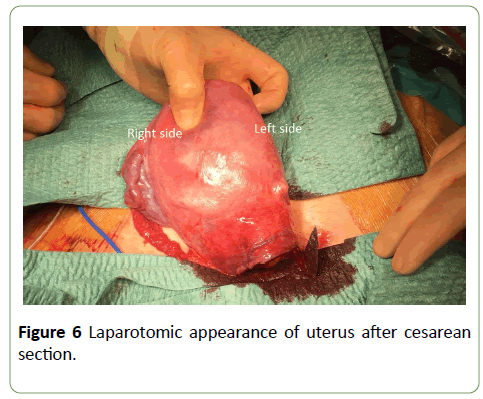Keywords
Uterine myoma; Rudimentary horn;
Unicornuate uterus pregnancies; Amenorrhea;
Dysmenorrhea; Hematometra; Hematosalpinx;
Intrauterine growth restriction; Placental abruption;
Laparoscopic resection; Retroperitoneal cord
Introduction
The prevalence of this anomalies in unselected population is
5.5%, 13.3% in those with history of miscarriage, 8% in infertile
women and highest than 24.5% in infertile women who also
had a history of miscarriage [1,2]. A unicornuate uterus
presents the 0.1% of women [3] and it constitutes
approximately 20% of Müllerian ducts anomalies [4]. The
rudimentary horn is recognized in about 74%-90% of these
cases [5]. Anomalies are more common in infertile women as
in women with repeated miscarriage and obstetric adverse
outcomes [6,7]. True prevalence is difficult to assess, partly
because different classification systems are used and partly
because best diagnostic techniques are invasive and rarely
applied to low-risk population [1,2,8].
Müllerian anomalies are frequently asymptomatic and are
often missed in routine gynecological examination [9].
Methods for the assessment of uterine morphology are threedimensional
ultrasound, hysterosalpingography, hysteroscopy,
laparoscopy and RMI [10]. In most cases, unicornuate uterus is
incidentally discovered when pelvis is imaged but sometimes it
can even be missed at time of laparotomy or laparoscopy by
inexperienced surgeons.
Various classification systems have been developed; the
latest is ESHRE-ESGE system that includes anatomical variation
of uterus, vagina and cervix in different classes [11]. This
classification is not in widespread use and does not allow
comparison, the most common classification of American
Fertility Society [12,13] AFS classification defines seven classes,
unicornuate uterus is represented in class II divided in four
subclasses: with communicating rudimentary horn, noncommunicating,
no cavity horn and no horn (Figure 1).
Figure 1: New classification and terminology of uterine malformations & contribution of the frontal view Echographic.
Clinical presentations for Müllerian anomalies are different;
when symptoms are present, range from amenorrhea,
dysmenorrhea, pelvic pain, hematometra, hematosalpinx and
adverse reproductive and obstetric outcomes as infertility,
spontaneous abortion, preterm delivery, malpresentation,
intrauterine growth restriction, placental abruption and
intrauterine fetal demise [14,15].
It is theorized it is due to diminished muscle mass abnormal
uterine blood flow and cervical incompetence [6,7].
Diagnosis and management of such types of anomalies are
often a challenge for the gynecologist.
We present a case report of a successful delivery in an
undiagnosed unicornuate uterus after laparoscopic resection
of a rudimentary horn at 14+5 weeks‘ gestation thought to be
an ovarian neoplasm.
Case Report
A 34-year-old Caucasian woman GII P0, with a spontaneous
pregnancy at 4 weeks of amenorrhea and positive urine
pregnancy test, comes to our observation because of vaginal
bleeding. She has a history of mild dysmenorrhea and
menorrhagia. In 2015 she experienced a twin pregnancy
miscarriage managed with a D&C (dilatation and curettage).
Transvaginal ultrasound revealed no gestational sac, normal
right ovary and left adnexal mass of 60*60 mm of mixed
echogenicity and increased vascular pattern. The image was
suspect for solid ovarian neoplasm.
A two week follow up was scheduled and a vaginal
ultrasound showed a yolk sac, without embryo. The evaluation
confirmed the left adnexal mass, tumor markers were negative (CA 125=29.7 U/ml, CA 15-3=21.6 U/ml, CA 19-9= 3.8 U/ml,
CEA=0.9 ng/ml, AFP 1.1 ug/l, LDH= 156 U/l) (Figures 2 and 3).
Figure 2: Echographic appearance of uterus and pelvic mass.
Figure 3: Echographic appearance of pelvic mass.
The patient was referred to our oncological multidisciplinary
team discussion (MDM) and the board decided for a follow up
by bi-weekly scan.
The first-trimester screening scan at 12 weeks‘ gestation
revealed ongoing pregnancy with a low risk for fetal trisomy
( T21, T13 eT18), but an increased risk of preeclampsia, IUGR
and preterm birth, the patient started prophylaxis with acetyl
salicylic acid from 12 to 36 weeks gestation. Because of the
increased size of the left adnexal mass, now measuring
73*74*80, the patient was referred again to the oncological
multidisciplinary team discussion and the board decided for an
explorative laparoscopy with adnexectomy.
At 14+5 weeks ‘gestation the patient underwent
laparoscopic examination under general anesthesia. The pelvic
status was the following: uterus in the midline, the right
fallopian tube, the right ovary, the right round ligament and
the utero-ovarian ligament were normal. The left aspect of the
uterus appeared smooth and without any adnexal landmark
(Figure 4).
Figure 4: Laparoscopic appearance of uterus and pelvic mass.
The left part of the pelvic cavity was occupied by a bulky
structure that was laterally connected with a normal ovary, a
fallopian tube was visible and of normal aspect, no left round
ligament was identified (Figure 5).
Figure 5: Laparoscopic appearance of left adnexa.
The mass appeared connected to the left lateral aspect of
the isthmic uterine region by a retroperitoneal cord. After
careful inspection of the anatomy and after identifying the
ureters course bilaterally, the resection of the mass was made.
We started with opening peritoneum, then transection of the
retroperitoneal cord in regard to the isthmic region of uterus
was made ultracision and bipolar forceps. Thereafter
coagulation and resection of left uterus-ovarian ligament,
followed by coagulation and resection of rudimentary broad
ligament. After careful control of hemostasys and ureteres
position, the surgical piece was extracted in a plastic bag
(endocatch). The macroscopic appearance was suggestive for
myoma. At the end of the surgery the ultrasound examination
showed a viable fetus with a normal fetal heartbeat. The
postoperative course was uneventful, and the patient was
discharged after 4 days.
Laparoscopic findings and hysto-pathological report brought
to a diagnosis of right unicornuate uterus with left
fibromatosic rudimentary horn. According to American Fertility
Society Classification this malformation comes under U4a/
U4b. At 21 week’s gestation, the second trimester screening scan showed a normal fetal anatomy, the placenta appeared to
be correctly inserted, no major signs for abnormally adherent
placenta were seen. The echographic measurement of the
cervical length showed a cervix of 25 mm. According to
national guidelines an intra-vaginal 200 mg progesterone
treatment started, and sonographic measurement of cervical
length every two weeks was scheduled. The first sign of
intrauterine growth restriction appeared at 30 weeks’
gestation: BPD and HC were at the first percentile, Doppler
evaluation of umbilical artery, middle cerebral artery and
ductus venosus were normal. The fetal presentation was
breech.
At 32 weeks’ gestation fetal growth remained stable at the
same percentile. Blood pressure was normal, no clinical signs
of preeclampsia and cervical length was stable at 25 mm.
Urinary proteins ‘value was 0.54 gm/l and protein/creatinine
ratio 12.9 mg/mmol.
After 3 weeks there were an increase of these values:
urinary proteins were 0.67 gm/l and protein/creatinine ratio
were 56.7 mg/mmol, daily blood pressure readings remained
normal, fetal weight estimation was at the 1st percentile,
Doppler evaluation of umbilical artery, middle cerebral artery
and ductus venosus were still normal. We arranged an elective
cesarean section at 37 weeks’ gestation after pulmonary
maturation with two intramuscular injections of
dexamethasone 12 mg. At 37+3 weeks ‘gestation a healthy boy
was delivered by cesarean section, the post-operative
appearance of the uterus confirmed the diagnosis of
unicornuate uterus (Figure 6).
Figure 6: Laparotomic appearance of uterus after cesarean section.
The baby weight was 2470 gr (5th percentile), 46 cm length,
Apgar score was 9-10-10. Both baby and mother were
discharged in good condition.
Discussion
In case of unicornuate uterus pregnancies can be either in
the primary uterine cavity or in the rudimentary horn.
Pregnancies developing in the rudimentary horn have to be
removed. This is the first report of laparoscopic resection of rudimentary horn, during ongoing pregnancy in the main horn;
several case reports described laparoscopic approach for
removal of the rudimentary horn, but no one during
pregnancy in unicornuate uterus.
Uterine anomalies should therefore be suspected in
pregnancies with atypical ultrasonographic features and more
investigations done to confirm the diagnosis, with a view to
improving management of clinical care. The first trimester
screening scan has not to focus only on fetus, it is also
important to observe thoroughly adnexal region and to
investigate possible unclear or suspected images in order to
reduce associated morbidity and mortality. Prophylactic
resection of a noncommunicating uterine horn with a cavity
should be considered in an asymptomatic, reproductive-age
patient with this rare Mullerian anomaly.
It would be safer to remove the rudimental horn outside
pregnancy to better manage future pregnancy, but this clinical
presentation did not allow us to make the proper diagnosis. As
a fast-increasing ovarian mass can represent a harmful event
for a young girl, it was mandatory to proceed with the surgery
in order to exclude ovarian cancer. It is interesting that an
accurate first trimester screening scan allow the clinician to
diagnose the high-risk cohort for intrauterine growth
restriction and preeclampsia. Moreover, the absence of the
left uterine artery during the scan should have brought our
attention toward the presence of uterine anomalies. The
balance of risks and benefits of results of serial ultrasound,
cervical length, blood pressure and urine protein follow-up
guided us to the choice of 37 weeks ‘gestation caesarean
section.
Conclusion
Unicornuate uterus is present in only 0.1% of population,
facing such challenging cases of anomaly, physician skills and
decisions are very important to manage pregnancy
complications at time of appearance because of a lack of
literature for evidence-based decision making. Though rare,
uterine Müllerian anomalies as unicornuate uterus should be
included in differential diagnosis facing pelvic unrecognised
mass, dysmenorrhea, and first trimester miscarriage: that is
essential to provide better care to patients. Prophylactic
resection should be considered in an asymptomatic,
reproductive-age, because surgical resection of rudimental
horn may improve obstetric outcomes in selected cases such
as ours. Future reports will define optimal management
approach.
Conflict of Interest
The authors have no conflicts of interest to report with this
research.
References
- Chan YY, Jayaprakasan K, Tan A, Thornton JG, Coomarasamy A, et al. (2011) Reproductive outcomes in women with congenital uterine anomalies: a systematic review. Ultrasound Obstet Gynecol 38: 371-382.
- Chan YY, Jayaprakasan K, Zamora J, Thornton JG, Raine-Fenning N, et al. (2011) The prevalence of congenital uterine anomalies in unselected and high-risk population: a systematic review. Hum Reprod Update 17: 761-771.
- Al Qarni AA, Al-Braikan N, Al-Hanbali MM, Alharmaly AH (2017) Rupture rudimentary horn pregnancy at 31 week. Saudi Med J 38: 201-203.
- Khati NJ, Frazier AA, Brindle KA (2012) The unicornuate uterus and its variants. J Ultrasound Med 31: 319-331.
- Kanno Y, Suzuki T, Nakamura E, Goya K, Nishijama Y, et al. (2014) Successful term delivery after laparoscopic resection of a non-communicating rudimentary horn in a patient with a unicornuate uterus: A case report. Tokai J Exp Clin Med 39: 59-63.
- Reichman D, Laufer MR, Robinson BK (2009) Pregnancy outcomes in unicornuate uteri: a review. Fertil Steril 91: 1886-1894.
- Hua M, Odibo AO, Longman RE, Macones GA, Roehl KA, et al. (2011) Congenital uterine anomalies and adverse pregnancy outcomes. Am J Obstet Gynecol 205: 558.e1-558.e5.
- Caserta D, Mallozzi M, Meldolesi C, Bianchi P, Moscarini M (2014) Pregnancy in a unicornuate uterus: A case report. J Med Case Rep 8: 130.
- Nahum GG (2005) Uterine anomalies, induction of labor, and uterine rupture. Obstet Gynecol 106: 1150-1152.
- Salim R, Woelfer B, Backos M, Regan L, Jurkovic D (2003) Reproducibility of three-dimensional ultrasound diagnosis of congenital uterine anomalies. Ultrasound Obstet Gynecol 21: 578-582.
- Grimbizis GF, Gordts S, Di Spiezio Sardo A, Brucker S, De Angelis C, et al. (2013) The ESHRE/ESGE consensus on the classification of female genital tract congenital anomalies. Hum Reprod 28: 2032-2044.
- Prior M, Richardson A, Asif S, Polanski L, Parris-Larkin M, et al. (2018) Outcome of assisted reproduction in women with congenital uterine anomalies: a prospective observational study. Ultrasound Obstet Gynecol 51: 110-117.

